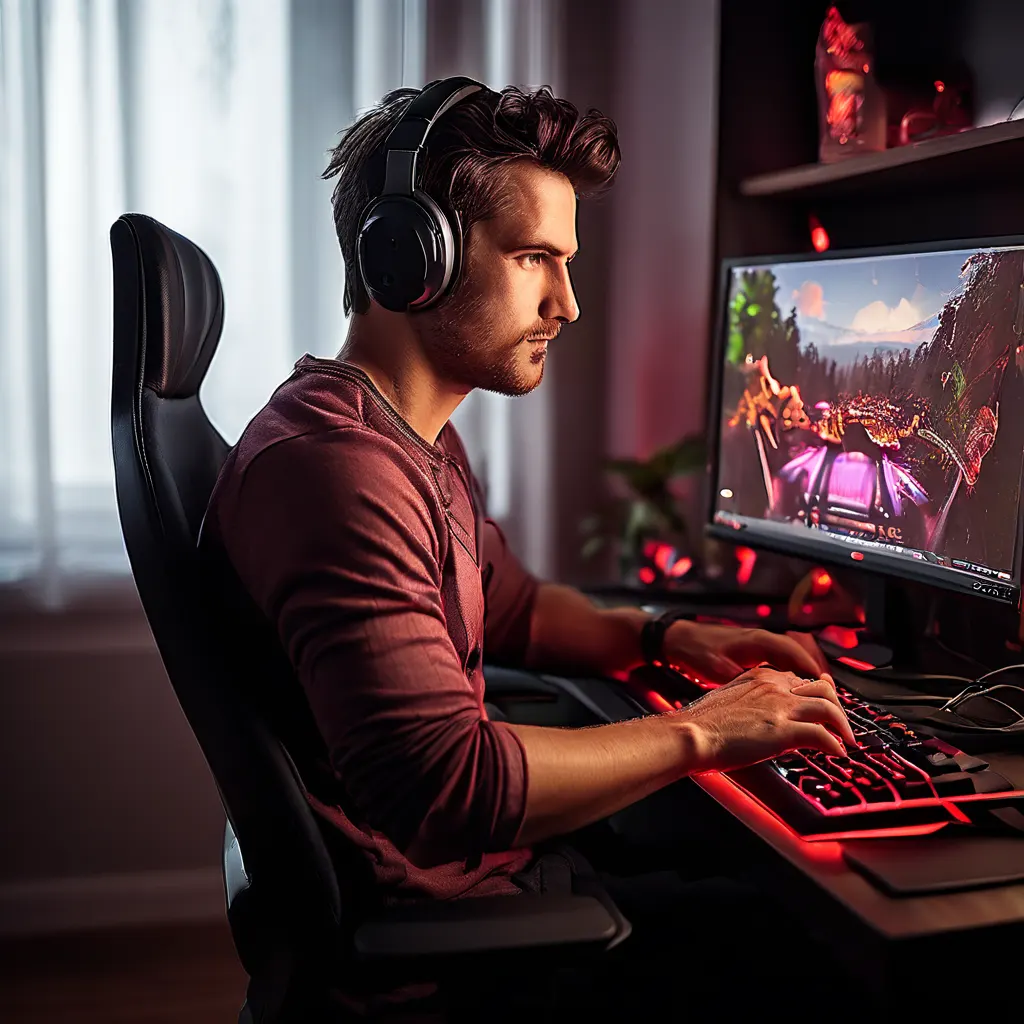
Gaming is more than just a hobby—it’s a way to unwind, connect with friends, and escape into virtual worlds.
However, prolonged gaming sessions can lead to poor posture, causing discomfort and potentially leading to long-term health issues.
This guide will help you understand why maintaining proper posture is crucial for health and gaming performance.
When you spend hours in front of a screen, hunching over your controller or slumping in a chair, your body suffers. Common ailments such as lower back pain, neck strain, and carpal tunnel syndrome can occur.
These issues not only impact your health but also reduce your gaming performance. By focusing on good posture, you can avoid these problems and enjoy gaming for longer periods without discomfort.
Understanding Gaming Posture

Gaming posture refers to the body position you adopt while playing video games. For most gamers, this involves sitting in a chair or on a couch, using a keyboard and mouse, or holding a controller.
While this might seem straightforward, improper posture can lead to a host of problems, ranging from minor discomfort to serious medical conditions.
What Causes Poor Gaming Posture?
Several factors contribute to poor gaming posture, including:
- Slumping in a chair: This is common when the chair lacks proper support or when gamers sit for extended periods without adjusting their position.
- Hunching over a controller: This often occurs during intense gaming sessions, leading to rounded shoulders and strained neck muscles.
- Incorrect monitor placement: When the monitor is too high or too low, it causes the gamer to tilt their head, creating strain on the neck and upper back.
–Improper keyboard positioning: A keyboard that’s too high or too low forces awkward wrist and arm movements, increasing the risk of carpal tunnel syndrome.
Common Ailments Linked to Poor Gaming Posture
Here are some common ailments that gamers face due to poor posture:
- Lower back pain: Often caused by slumping or lack of lumbar support.
- Neck pain: Resulting from tilting the head forward or backward for long periods.
- Carpal tunnel syndrome: Caused by repetitive wrist movements without proper support.
- Shoulder tension: Often the result of hunching or raised shoulders during gaming.
- Gamer’s thumb: A condition that affects the tendons in the thumb due to excessive use.
The Importance of Proper Gaming Posture
Proper gaming posture helps avoid these ailments by maintaining a neutral and aligned body position. It not only reduces the risk of injuries but also allows gamers to stay focused and motivated for longer periods.
Correct posture also improves lung capacity and breathing, which can enhance overall health and performance.
Related Post: How to Clean a Gaming Chair: Step-by-Step Guide
6 Ways to Improve Gaming Posture

Maintaining proper posture while gaming is essential for your health and gaming performance.
This section will guide you through six effective ways to improve your gaming posture, ensuring that you remain comfortable and injury-free during long gaming sessions.
1. Monitor Positioning
The position of your monitor plays a significant role in your posture. To avoid strain, your monitor should be at a comfortable distance and height.
- Distance: Keep your monitor 20-24 inches away from you to avoid eye strain and to maintain a proper viewing distance.
- Height: Your eyes should be level with the top third of the screen, allowing you to keep your head in a neutral position.
- Angle: Maintain a 90-degree angle with your monitor to avoid tilting your head, which can cause neck and back strain.
Why It Matters
Improper monitor positioning can lead to neck strain andslumping, causing pressure on your upper body and shoulders. It can also result in eye strain, reducing your gaming performance. Proper monitor positioning keeps your spine aligned and reduces discomfort during extended gaming sessions.
2. Keyboard and Mouse Positioning
Your keyboard and mouse should be at the correct height and angle to reduce strain on your wrists and arms.
- Keyboard Height: Place your keyboard about 2-3 inches above your knees, allowing you to maintain a relaxed and comfortable position without reaching or hunching.
- Mouse Control: Use your elbow to control the mouse, not just your wrist. This prevents excess strain on your wrist tendons.
Why It Matters
Gamers often perform rapid movements with their wrists and fingers, leading to conditions like carpal tunnel syndrome.
Proper keyboard and mouse positioning helps reduce strain on the tendons and small muscles in your hands and arms, improving comfort and reducing the risk of injury.
3. Arm and Wrist Positioning
The positioning of your arms and wrists is crucial for maintaining proper gaming posture and reducing muscle strain.
- Elbow Angle:Keep your elbows at a 90-degree angle to maintain relaxed shoulders and a neutral wrist position.
- Neutral Wrists: Ensure that your wrists are straight, avoiding awkward angles that could lead to strain and discomfort.
Why It Matters
This positioning helps you avoid wrist strain, arm pain, muscle injuries, and carpal tunnel syndrome. It also reduces tension in your shoulders and neck, allowing you to focus on gaming without discomfort.
Next Steps
These first three tips focus on your upper body positioning. The following tips will address lower back support, head and neck positioning, and proper foot placement.
4. Head, Neck, and Shoulders Positioning
Proper positioning of your head, neck, and shoulders is crucial for maintaining good gaming posture and avoiding discomfort. Here’s how to ensure you’re sitting correctly to reduce strain on these areas.
- Head Positioning: Your head should be directly above your spine, with your chin slightly tucked to avoid tilting forward or backward.
- Shoulders: Keep your shoulders relaxed and not raised, even during intense gaming moments. This helps prevent shoulder tension and muscle strain.
- Neck Alignment: Ensure your neck is in a neutral position, avoiding excessive forward or backward tilt.
Why It Matters
Your head is heavier than you might think, so it needs proper support. Tilting your head forward or backward puts extra strain on your neck and shoulder muscles, leading to discomfort and tension headaches.
By maintaining a neutral position, you reduce stress on these areas and improve your overall gaming performance.
5. Lower Back Support
Supporting your lower back is key to maintaining good posture during gaming. Lumbar support ensures your spinal curves are protected and reduces the strain on your back muscles.
- Lumbar Support: An ergonomic chair with built-in lumbar support is ideal, but if your chair doesn’t have it, you can add a pillow or a lumbar cushion.
- Alignment: Keep your hips, shoulders, and ears aligned to avoid slumping and rounding your lower back.
Why It Matters
Without proper lumbar support, your spine can suffer, leading to serious medical concerns like poor core muscles and joint degeneration.
Supporting your lower back reduces the risk of back pain and allows your muscles to relax, ensuring a comfortable gaming experience.
6. Foot Positioning
Proper foot placement is essential for good posture and body alignment during gaming sessions.
- Feet on the Floor: Keep your feet flat on the floor to maintain stability. If your feet can’t touch the floor, use a stool or footrest for support.
- Leg Positioning: Your thighs should be parallel to thefloor, with knees at a 90-degree angle. Avoid crossing your legs or tucking them under your chair.
Why It Matters
Crossing your legs or sitting in different positions can put pressure on your spine and intervertebral discs, leading to back pain and muscle tension.
Keeping your feet flat on the floor with knees at a 90-degree angle ensures proper alignment and reduces strain on your lower back and legs.
Read Also: Gaming Chairs vs. Office Chairs: Which Should I Pick?
Additional Tips for a Healthy Gaming Experience

In addition to focusing on proper posture, there are several other practices you can incorporate into your gaming routine to ensure a healthier experience.
These tips can help you stay comfortable, reduce the risk of injury, and maintain your overall well-being.
1. Take Regular Breaks
Long gaming sessions can cause stiffness and strain on your muscles and joints. To combat this, take regular breaks to stretch and move around.
- Frequency: Aim to take a 5-10 minute break every hour. This can be as simple as standing up, stretching, or walking around.
- Benefits: Breaks help prevent stiffness, reduce eye strain, and give your body a chance to recover from repetitive movements.
2. Stretch and Exercise
Incorporating stretching and light exercise into your routine can improve flexibility and reduce muscle tension.
- Daily Stretches: Focus on stretching your neck, shoulders, back, wrists, and legs. This helps keep your muscles flexible and reduces the risk of injury.
- Regular Exercise: Engage in physical activities like walking, jogging, or yoga to strengthen your core and improve overall fitness.
3. Set Limits on Gaming Time
Playing for extended periods without a break can lead to burnout and physical discomfort. Setting limits on your gaming time helps you maintain a balanced lifestyle.
- Daily Limits: Decide on a maximum amount of time you will game each day. This can vary depending on your schedule and personal preferences.
- Balanced Schedule: Include other activities in your day, like socializing, exercising, or pursuing other hobbies.
4. Ensure Adequate Sleep
Proper rest is crucial for your health and gaming performance. Lack of sleep can lead to decreased focus and slower reaction times.
- Sleep Schedule: Aim for 7-9 hours of sleep per night to ensure you’re well-rested.
- Consistent Routine: Establish a bedtime routine to help you relax and fall asleep more easily.
5. Stay Hydrated
Hydration is often overlooked during long gaming sessions, but it’s essential for maintaining focus and energy.
- Water Intake: Drink plenty of water throughout the day. Keep a water bottle nearby during gaming sessions to remind yourself to stay hydrated.
- Avoid Dehydration: Dehydration can lead to headaches, fatigue, and reduced concentration, all of which can impact your gaming performance.
Benefits of Proper Gaming Posture
Proper gaming posture offers a wide range of benefits, not just for your physical health but also for your gaming performance.
Let’s explore the advantages of maintaining good posture during gaming sessions and why it is crucial for a better experience.
Physical Health Benefits
Good posture reduces the risk of various physical ailments and contributes to a healthier gaming routine. Here are some key health benefits:
- Reduced Risk of Carpal Tunnel Syndrome: Proper positioning of your wrists and hands minimizes strain, lowering the risk of carpal tunnel syndrome and other repetitive strain injuries.
- Relieves Tension and Pressure: Correct posture alleviates tension in your neck, shoulders, and back, reducing discomfort and pressure during gaming.
- Strengthens Core Muscles: Sitting with proper alignment engages your core muscles, helping to strengthen them over time.
- Avoids Joint Degeneration: Supporting your lower back and keeping your spine aligned helps prevent joint degeneration and other serious medical conditions.
- Fewer Headaches: Maintaining a neutral head and neck position reduces the likelihood of tension headaches and other related issues.
- Improves Lung Capacity: Sitting up straight opens your chest, allowing for better lung capacity and easier breathing.
Gaming Performance Benefits
In addition to the health advantages, proper posture can significantly enhance your gaming performance. Here’s how:
- Improved Focus and Concentration: When your body is comfortable, you’re less likely to be distracted by pain or discomfort, allowing you to focus on the game.
- Boosted Confidence and Mood: Good posture can improve your confidence and mood, leading to a more enjoyable gaming experience.
- Longer Gaming Sessions: Proper posture allows you to game for longer periods without experiencing fatigue or discomfort.
- Enhanced Reaction Times: With reduced tension and pressure on your body, your reaction times and overall gaming performance can improve.
The Ripple Effect of Good Posture
Maintaining proper posture has a positive ripple effect on other aspects of your life. It can lead to better sleep, improved energy levels, and increased motivation.
When you feel better physically, it can translate to improved mental health and overall well-being.
By adopting the posture tips mentioned earlier and incorporating additional healthy gaming practices, you can experience these benefits firsthand.
Ergonomic Gaming Chairs: Features to Consider
Investing in an ergonomic gaming chair is one of the most effective ways to maintain proper posture during gaming sessions.
These chairs are designed with comfort and health in mind, offering a range of features to support your body and reduce the risk of injuries. Here are some key features to consider when choosing an ergonomic gaming chair.
Headrest
A headrest provides essential support for your neck, shoulders, and upper back. When properly adjusted, it can prevent neck strain and improve overall comfort during long gaming sessions.
- Adjustable Headrest: A headrest that can be adjusted to fit the curvature of your neck is ideal. This ensures that it doesn’t interfere with your natural movements and offers the right level of support.
Armrests
Armrests are crucial for maintaining proper arm and wrist positioning while gaming. They help relieve the muscles of your back, shoulders, and neck by providing extra support.
- 4D Armrests: Look for armrests that can be adjusted up and down, side to side, front to back, and in and out. This level of flexibility allows you to find the most comfortable position for your arms and wrists.
- Comfortable Positioning: Properly adjusted armrests can reduce strain on your shoulders and wrists, helping you maintain a neutral posture.
Back Support
Good back support is essential for preventing slumping and supporting your lower back. An ergonomic gaming chair should have a well-designed backrest and lumbar support.
- Lumbar Support: Built-in lumbar support helps maintain the natural curve of your spine and reduces strain on your lower back muscles. Some chairs offer adjustable lumbar support for personalized comfort.
- Backrest Adjustability: A chair with an adjustable backrest allows you to find the perfect angle for your comfort, whether you prefer a more upright position or a slight recline.
Adjustability
The ability to adjust your chair to fit your body size and shape is a key feature of ergonomic gaming chairs. This ensures proper alignment and even weight distribution.
- Seat Depth Adjustment: This feature allows you to adjust the depth of the seat to support your upper legs and maintain proper alignment.
- Forward Tilt: Some chairs offer a forward tilt option, which supports different sitting styles and can help you maintain an active posture.
- Swivel Rotation and Wheels: High-quality wheels and swivel rotation provide extra mobility and make it easier to move around while gaming.
Other Features
Additional features can further enhance your comfort and gaming experience. Consider the following:
- Breathable Fabric: Chairs with breathable fabric or mesh help keep you cool during long gaming sessions.
- Durability: Look for chairs made from high-quality materials that are built to last.
- Weight Capacity: Ensure the chair’s weight capacity meets your requirements for stability and safety.
Investing in a quality ergonomic gaming chair with these features can make a significant difference in your gaming posture and overall comfort.
Conclusion: Why Proper Posture Matters
Maintaining proper posture during gaming sessions is more than just a matter of comfort; it is crucial for your health, performance, and long-term well-being.
Poor gaming posture can lead to various physical ailments, including back pain, neck strain, and carpal tunnel syndrome, all of which can detract from your gaming experience and impact your quality of life.
By implementing the tips outlined in this guide, you can significantly reduce the risk of these issues and enjoy gaming in a more comfortable and sustainable manner. Here’s a summary of why proper posture is essential and how it can benefit you:
Health and Wellness
Good posture ensures that your body is aligned, reducing strain on your muscles and joints. This can lead to a decrease in tension, fewer headaches, and improved lung capacity.
Moreover, proper posture supports your core muscles, helping you maintain a healthier and more active lifestyle.
Gaming Performance
Proper posture can directly impact your gaming performance. When you’re comfortable, you can focus more on the game, leading to improved reaction times and overall performance.
A neutral posture can boost your confidence, allowing you to game for longer periods without discomfort or fatigue.
Longevity in Gaming
Maintaining good posture not only benefits you in the short term but also supports your gaming longevity. By reducing the risk of long-term injuries and joint degeneration, you can continue to enjoy gaming for years to come without compromising your health.
Final Thoughts
To maintain proper gaming posture, remember these key principles:
- Keep your monitor at a proper distance and height to avoid neck strain.
- Position your keyboard and mouse at a comfortable level to reduce wrist strain.
- Support your lower back with an ergonomic chair or a pillow.
- Keep your feet flat on the floor to maintain stability.
- Take regular breaks, stretch, and stay hydrated for overall health and well-being.
With these practices, you can create a more ergonomic gaming setup that promotes good health and enhances your gaming performance.
